Udaipur Palace Silver

Beez Neez now Chy Whella
Big Bear and Pepe Millard
Wed 24 Apr 2019 22:27
|
Udaipur City Palace Silver Collection
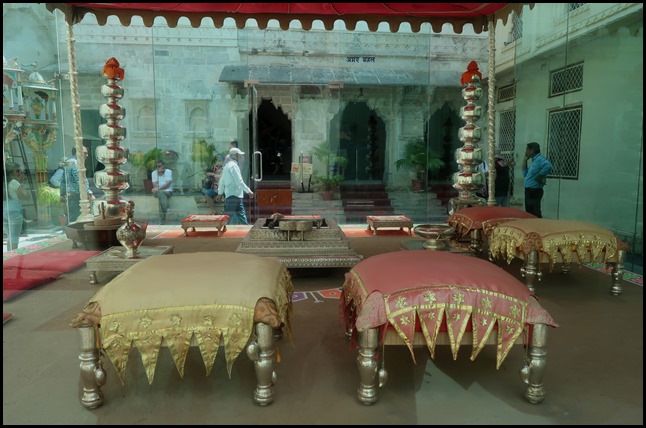 We had a little time before we left
the City Palace before our lake ride so we took in the Silver Collection.
Following the arrows, we rounded a corner and in front of us was a huge glass
square. The information board read:- Mandap (Hindu
Marriage Pavilion). 20th Century. Biyah or wedding is one of the most
important rites of passage in the Hindu life. The wedding usually takes place in
the open, on earth, around a sacred fire.
The mandap or pavilion
comprises four pillars, that sometimes support a canopy but it is essentially
open to the sky. Since the four poles are arranged in a square with a fire in
the centre, the mandap is a mandala, (Sanskrit for circle) and
thus, like all mandalas, the mandap stands for stability and order. The fire is
arranged in the centre in a kunda (container) that is usually made
of brick. An elaborate ceremony is organised by a special priest familiar
with performing the rites. The core ceremony is essentially a Vedic Yajna (Fire
Sacrifice).
The fire is worshipped and
symbolic offerings of rice, ghee, fruits, cotton seeds, flowers etc. are
submitted to the Divinity while chanting appropriate and sacred mantras.
Ghee (clarified butter) and wood are periodically added as fuel to keep the
fire going. The final culmination in a series of complex rituals, each with its
own deep significance, is the circumambulation of the fire by the bride and
groom, seven times.
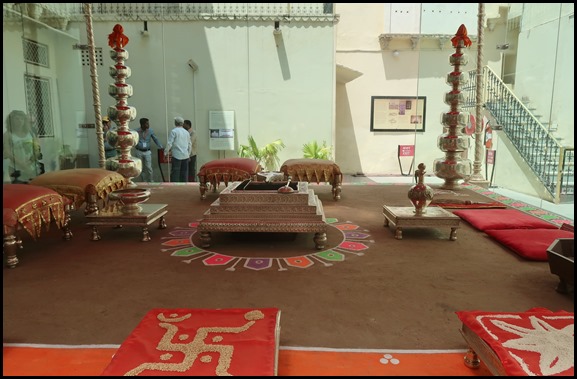 Bimbling around we saw the mandap from the other side.
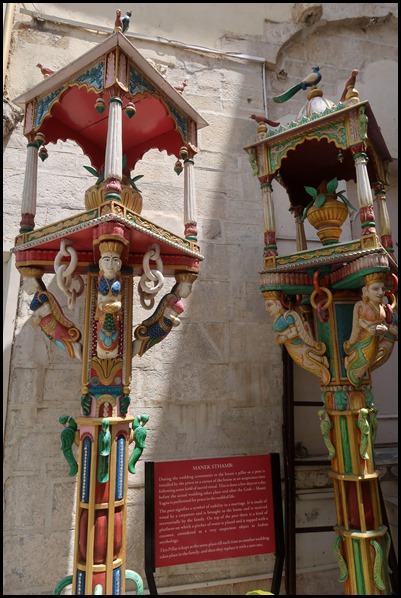 Manek Sthamb:
During the wedding ceremonies in the house a
pillar or post is installed by the priest in a corner of the house at an
auspicious time following some kind of sacred ritual. This is done a few days or
a day before the actual wedding takes place and after the Grah – Shanti Yagna is
performed for peace in the wedded life.
The post signifies a symbol of
stability in a marriage. It is made of wood by a carpenter and is brought to the
house and is received reverentially by the family. On top of the post there is a
kind of platform on which a pitcher of water is placed and is topped with a
coconut, considered as a very auspicious object in Indian
mythology.
This pillar is kept at the same
place till such time as another wedding takes place in the family, and then they
replace it with a new one. We stepped into the collection, on our
right......
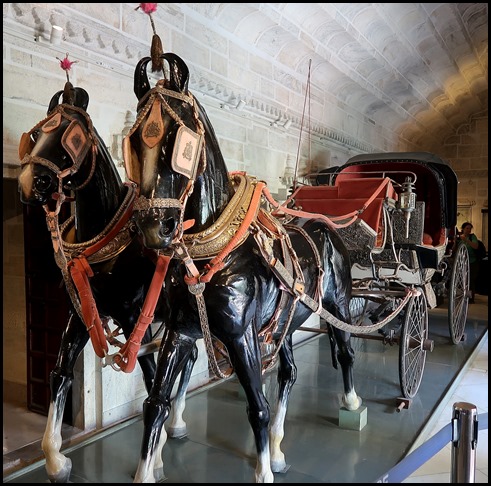 Buggy
(Carriage) Circa 1940.This carriage made of silver crafted abroad, is a
fine example of their informed patronage of European crafts of the 20th century.
This opulent landau was a gift given by the Royal House of Bikaner to celebrate
a marriage between the Mewar and Bikaner families. The merger is also reflected
in the symbolic decoration of the body ranging from the Coat-of-Arms of the
Royal House of Bikaner to panels depicting lion and boar hunting scenes
associated with the valour and bravery of the Rajput kings. On a gentler note
prancing cupids symbolising love decorate the carriage panel rims.
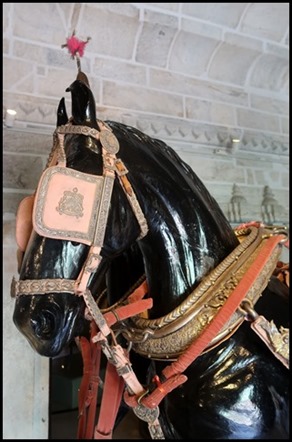 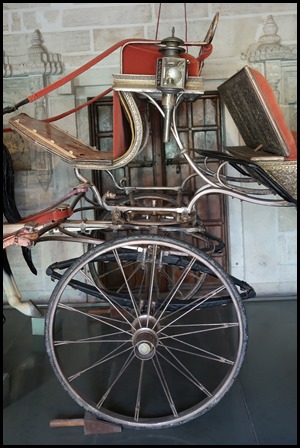 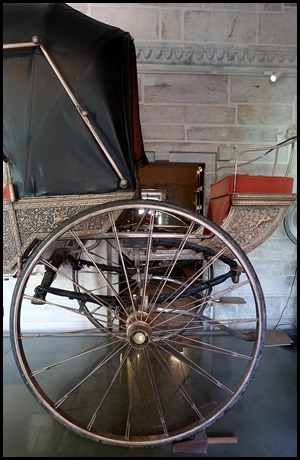 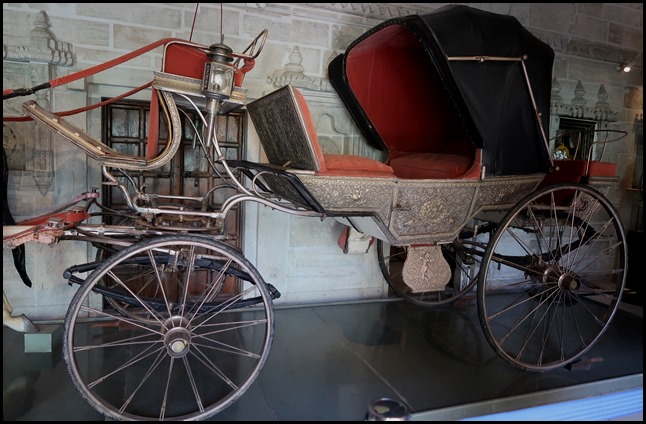 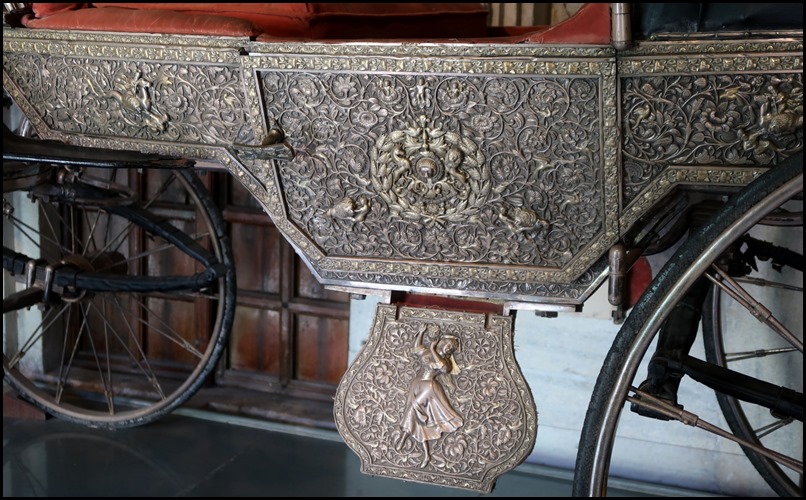 A closer
look at the detailing.
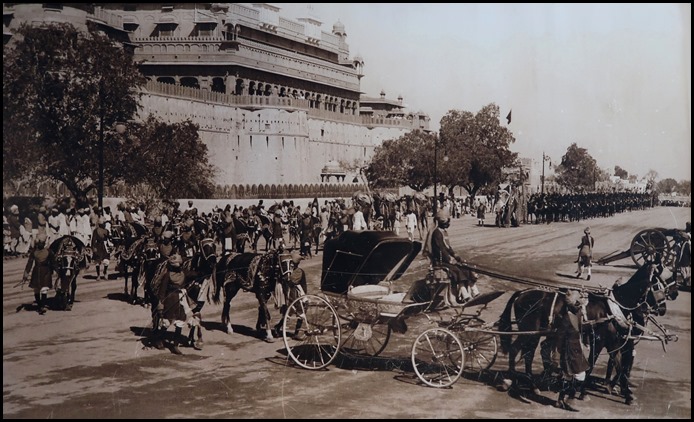 Photograph of
the Silver Buggy by Frederic Selby & Co. Ltd., Birmingham as part of
the wedding dowry from Bikaner State to Princess Sushila Kumari ji Bikaner on
the auspicious occasion of her wedding to Maharaj Kumar Bhagwat Singh ji of
Udaipur on 29th February 1940, seen in procession outside Junagarh Fort
Bikaner.
Splendour of Silver: Silver has
long held a cherished place for people across India. The Indian subcontinent has
little natural deposits of this metal, yet it is widely used and loved, a fact
attributable to a history of trade stretching back to almost two thousand years.
Coupled with traditions of hereditary silversmithing passed down from father to
son, Indian silver is remarkable for its limitless forms, noted for its
technical perfection and characterised by its varied use.
Silver is held sacred in
traditional Hindu beliefs, which associate the beautiful white metal with the
cool moon, surpassed only in importance by warm gold. Its association with
purity and religion is also the reason silver is extensively used by royalty.
Additionally, unlike gold which is highly malleable, silver is strong enough to
allow the fashioning of sturdier objects and could thus be put to more robust
and varied use, including transport.
The artists who produced these
beautiful items for royal and ritual use have largely remained nameless.
Produced for gods and rulers, the act of creation was considered a form of
obeisance and the objects themselves remain the only and perhaps the most
telling witness to their skill.
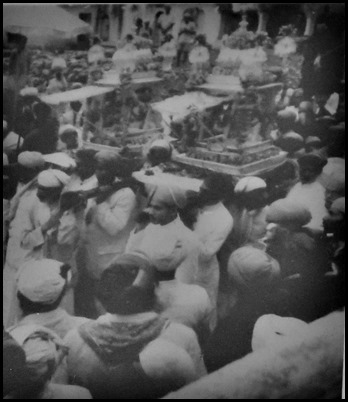 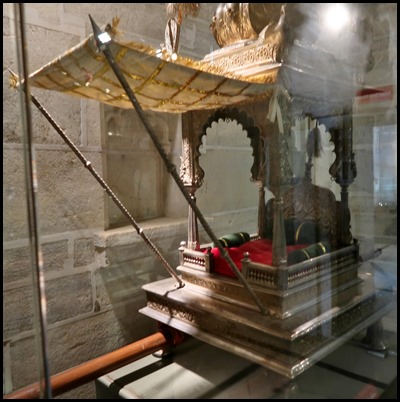 Maharaj
Kumar Saheb Bhagwat Singhji of Udaipur (p. 1940-1955) carrying the Ram Rewari on his shoulders on the occasion of Jaljhulani
Ekadashi (a festival where Hindus
worship the Vamana Avatar of Lord
Vishn).
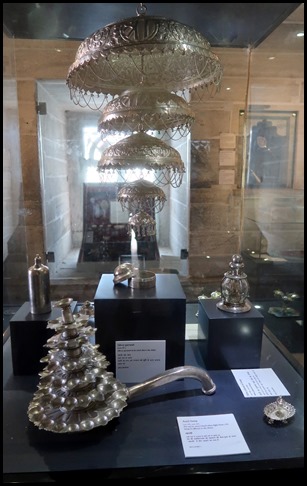
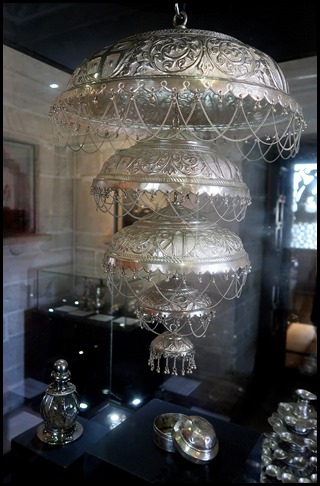 In the next room this display caught our eye. An Aarti Lamp (bottom left) (Late 19th early 20th century),
for use in aarti ritual when light from a lit lamp is offered to a deity and
a silver parasol (early 20th century), to be
used above a deity.
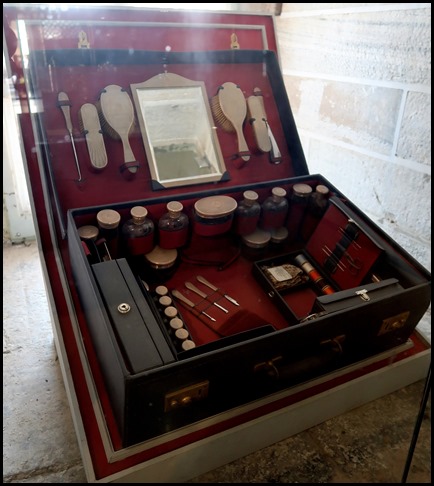 Leather
travelling dressing case, 1920’s. The sterling
silver mounts bears the coat of arms of the house of Bikaver – Hallmarked London
– The Makers Mark, SD. London Silversmith Charles Henry Dumenil. This case was
part of the wedding dowry of Princess of Bikaner on the auspicious occasion of
her wedding.
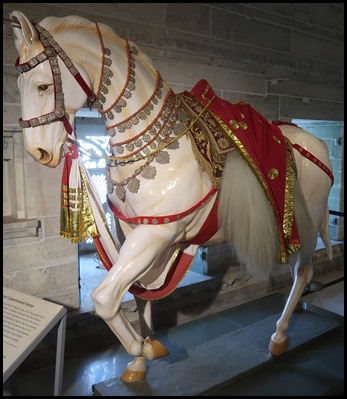 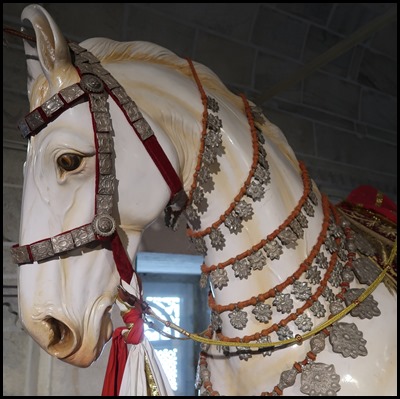 Traditional Caparisoned Horse (meaning to be
decked out in rich decorative coverings). Horses are intrinsic to the
warrior Rajput’s way of life. The prized horse of this region was the Marwari or
Malani, originally from Jodhpur or Marwar area and bred under strict regulations
from the 12th century onwards. Noted for their loyalty and bravery in battle,
they are instantly recognisable for their inward-turning ear tips that meet at
the centre. Known for their sharp instincts, loyalty and endurance, it was
believed that the Marwari could leave a battlefield only under three conditions
– victory, death, or carrying a wounded master to safety.
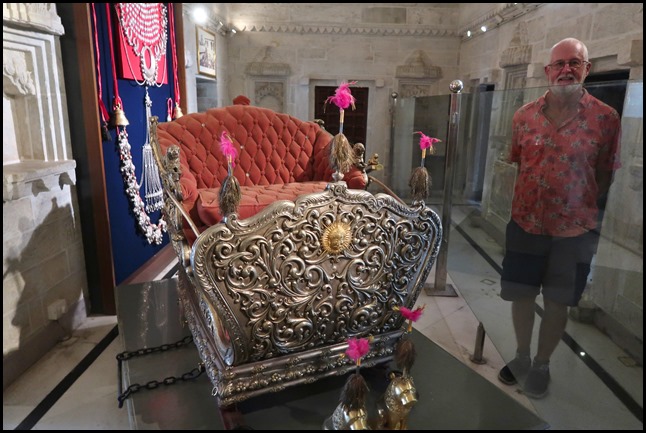
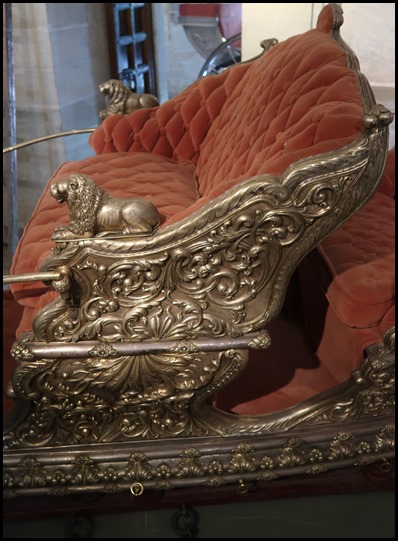 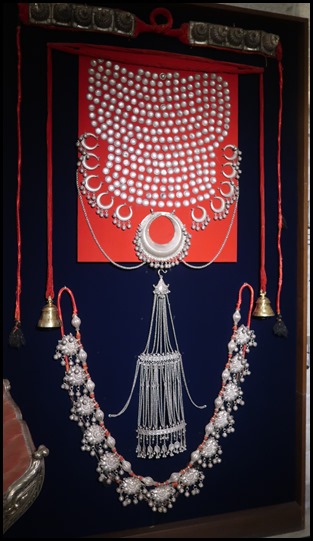 Howdah (Elephant Litter). Late 19th century. The animal
associated most closely with Rajpoot royalty are the elephant and horse. Their
importance was especially evident on days of religious or royal significance,
when they would be bedecked and either be worshipped or participate in the
rituals or processions. In addition the elephant would be decorated by a wide
variety of glittering textiles and ornaments for the head,
neck and legs.
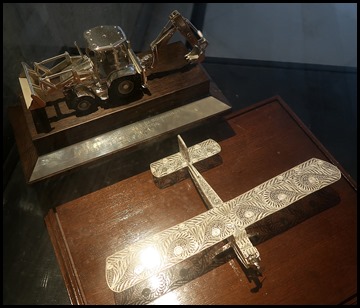 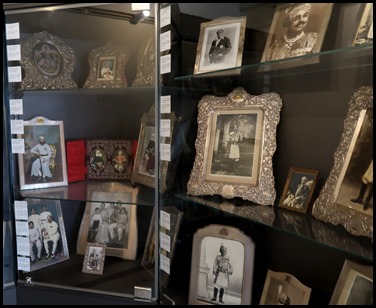 A little odd
to see a silver tractor behind the aeroplane...... Family pictures
in silver frames.
 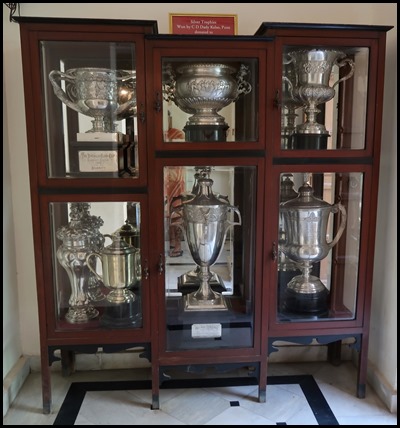 H.H. The Mahrajah’s Cup Mysore 1914 won by Cherry Wood
and a cabinet full of
trophies.
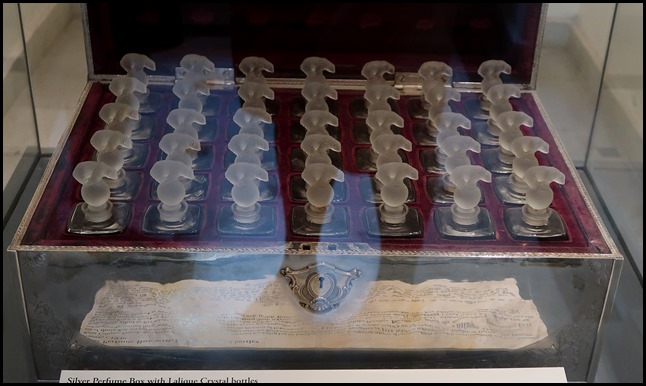 Silver
Perfume Box with Lalique Crystal Bottles. France. c,1930. Rene Lalique, French
designer of decorative arts was renowned for bringing his jeweler’s eye while
designing objects d’art. Amongst his early commissions was this charming set of
thirty-five crystal bottles with ‘circus bears’ stoppers made for Princess
Kailash Kumari Devi, daughter of H.H. Maharaja Rajendra Narayan Singh Deo of
Patna Balangir, Odisha.
It was
then gifted to Princess Nivritti Kumari Singh Deo by her grandmother, the
present Rajmata Sahiba Premlata Kumari Devi, after the demise of her grandfather
H.H. Maharaja Raj Raj Singh Deo of Patna Balangir. The silver box came to
Udaipur in December 2013 when H.H. Maharaja Sahib K.V. Singh Deo of Patna
Balangir presented it to Maharaj Kumar Sahib Lakshyaraj Singh Mewar of Udaipur
on the auspicious occasion of his engagement (Tilak Dastur) with Princess
Navritti Kumari Singh Deo of Patna Balangir. This family heirloom with its rich
history was donated to The City Palace Museum, Udaipur by Maharaj Kumar Sahib
Lakshyaraj Singh Mewar. (I need a cup of tea after typing
that).
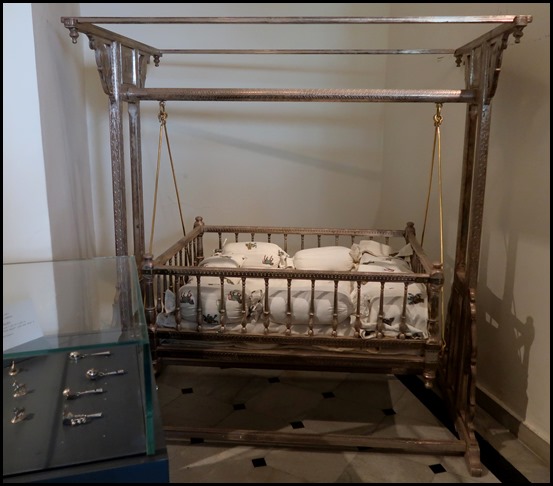 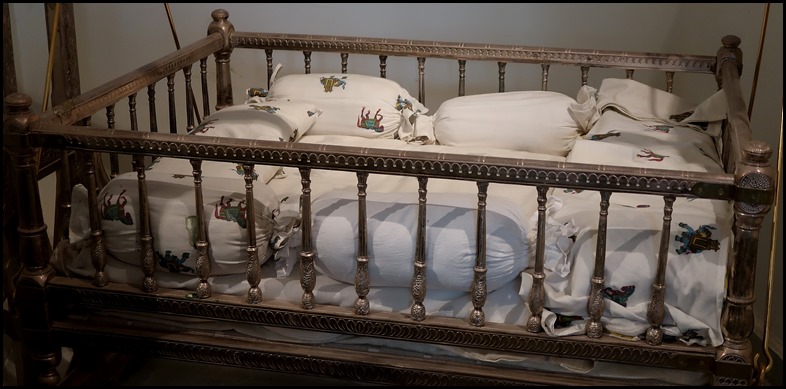 Silver swing crib with rattles in
display case. Time to nip a bit quick for our boat ride on the
lake.
ALL IN ALL SOME VERY LOVELY
PIECES
GOOD WEDDING
PRESENTS...... |